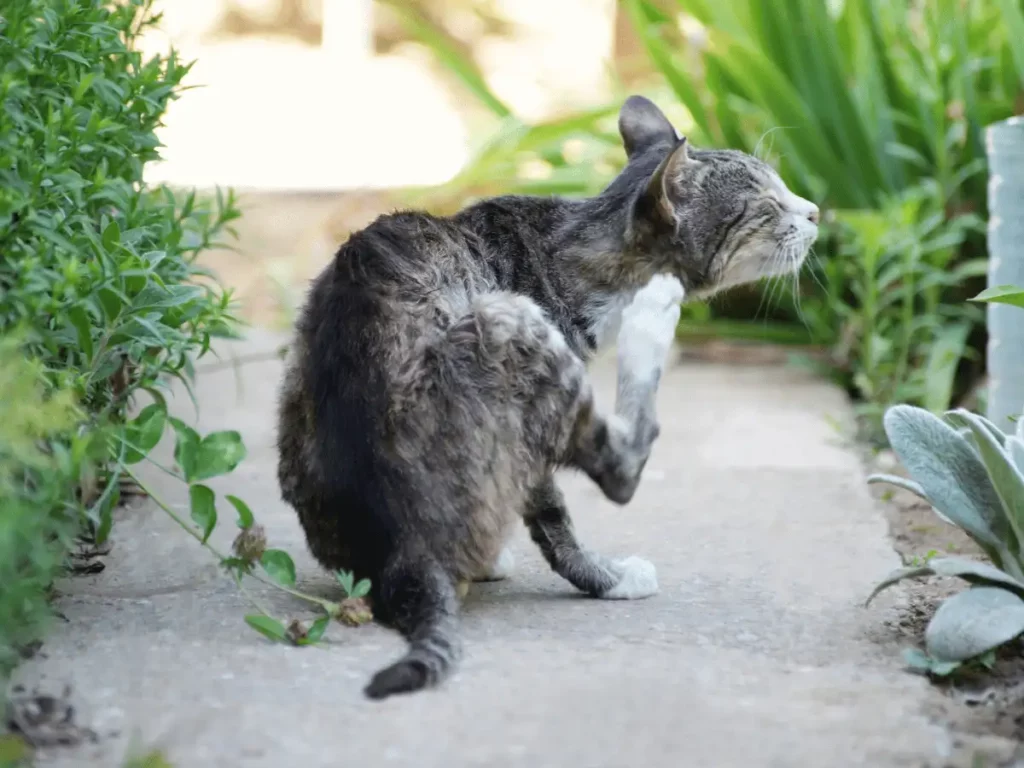
Have you ever wondered, “How do cats get fleas indoors?” It’s a common misconception that indoor cats are immune to these parasites, but the truth is fleas can find their way into any home and onto your feline friend.
As a seasoned cat mom, I’ve dealt with my fair share of cat-related challenges, including the pesky problem of indoor flea infestations. Drawing from my own experiences and the shared wisdom of our cat-loving community, I’m here to help you understand and tackle this common but frustrating issue.
In this article, we’ll explore:
- The various ways indoor cats can contract fleas.
- Recognizing the signs of an infestation.
- Effective flea treatments.
- Preventative measures to protect your beloved pet and home.
Lifecycle of a Flea: From Egg to Infestation
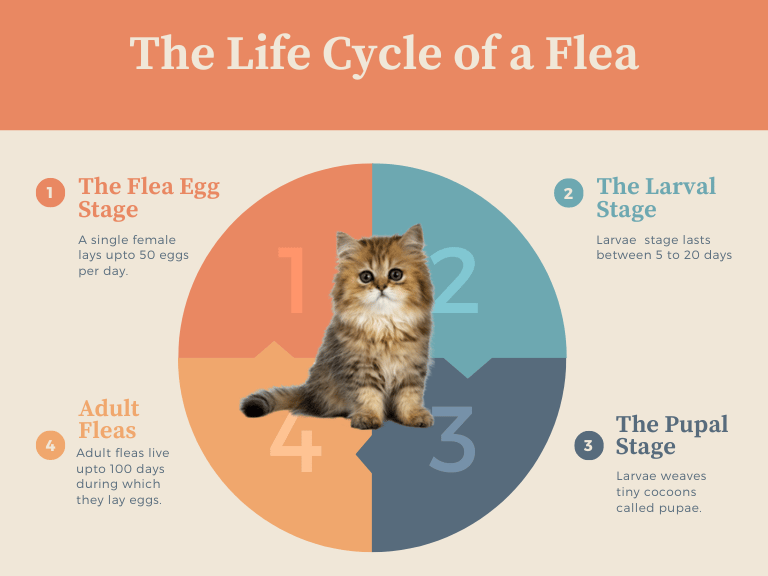
The Flea Egg Stage
It all starts with flea eggs, tiny specks that are easy to overlook. A single female flea can lay up to 50 eggs daily, totaling 2,000 in her lifetime. Talk about a family reunion nobody wants! Depending on the environment, eggs can take anywhere from two days to two weeks to hatch. Warm, humid conditions are their favorite (think summer or your cozy living room).
The Larval Stage
Next up, the larvae. These little wrigglers are less than a quarter-inch long and do not like light. They’ll burrow into carpets, cracks, and corners, feeding on whatever they can find – including the droppings from adult fleas. Ew, right? But for them, it’s all about survival for the next 5 to 20 days as they prepare for the pupal stage.
The Pupal Stage
The flea larvae weave tiny cocoons, where they transform into adult fleas. This stage can take as little as a week or stretch up to a year if conditions aren’t suitable for their grand debut.
Adult Fleas
Once they emerge, adult fleas are on a mission: to feed, reproduce, and make your life miserable. They can live up to 100 days, during which they’re busy laying more eggs and starting the cycle all over again.
How Do Cats Get Fleas Indoors?
1. Contact with Other Pets
Even if your feline friend is strictly an indoor dweller, they can still catch fleas from other pets in your home. Dogs, with their love for outdoor exploration, are notorious for bringing these tiny pests into your home. Once indoors, fleas can easily hop onto your cat and start a new infestation.
2. Rodent Infestations
Rodent infestations aren’t just a nuisance; they can also be a flea freeway into your home. Fleas of ten hitch a ride on rats and mice, making their way indoors, where they can jump ship and find a new host – your unsuspecting cat.
3. Visitors
Visitors with pets at home could unknowingly bring fleas into your house on their clothing or belongings. While it’s rare, it’s definitely possible! It’s always a good idea to remind visitors to leave their pet’s items, like blankets or toys, at home to reduce the risk of flea introduction.
If you find it awkward asking your guests to leave their pet accessories at home, don’t worry. Here are a few ideas on how to keep cats off your furniture.
4. Trips to the Great Outdoors
Sometimes, even the most dedicated indoor cat may venture outside. Whether for a vet visit, a trip to the groomer, or a supervised play session in the yard, these brief outdoor excursions can expose your cat to fleas.
5. The Risk of Used Furniture
That charming vintage sofa you saw at the flea market might be a steal, but it could also be harboring fleas. Fleas can live for several months without a host, so used or second-hand furniture can sometimes bring these unwanted guests into your home.
6. Neighborly Nuisances: The Perils of Proximity
Living close to neighbors with pets, particularly outdoors, can increase your cat’s risk of catching fleas. These tiny jumpers can quickly go from your neighbor’s pet into your home, finding a new host in your cat.
7. Encounters with Local Wildlife
If you live near a wooded area or have local wildlife visiting your yard, your indoor cat could be at risk for fleas. Fleas can hitch a ride on raccoons, possums, or other wildlife, making their way into your home and onto your cat.
8. The Risks of Swapping Pet Supplies
Exchanging pet supplies with friends or family can sometimes lead to a flea infestation. Something as simple as borrowing a pet bed or a cat toy can bring fleas into your home.
Recognizing the Signs of Flea Infestation
Spotting Allergic Reactions to Fleas
One of the first signs of a flea infestation is an allergic reaction. Your cat might have redness, bumps, or rashes on its skin. These are signs of flea allergy dermatitis, a condition where a cat is allergic to flea saliva. Your cat might be scratching more often, or you might spot small, inflamed sites where fleas have bitten. Don’t panic! While discomforting for your pet, these symptoms are a valuable clue in your detective work to confirm a flea infestation.
Increased Grooming and Skin Biting
Cats are known for their grooming habits, but excessive grooming can be a red flag. If your feline friend is spending more time licking, biting, or scratching their skin, it might be due to fleas. This increased grooming behavior is often a cat’s attempt to remove or kill fleas.
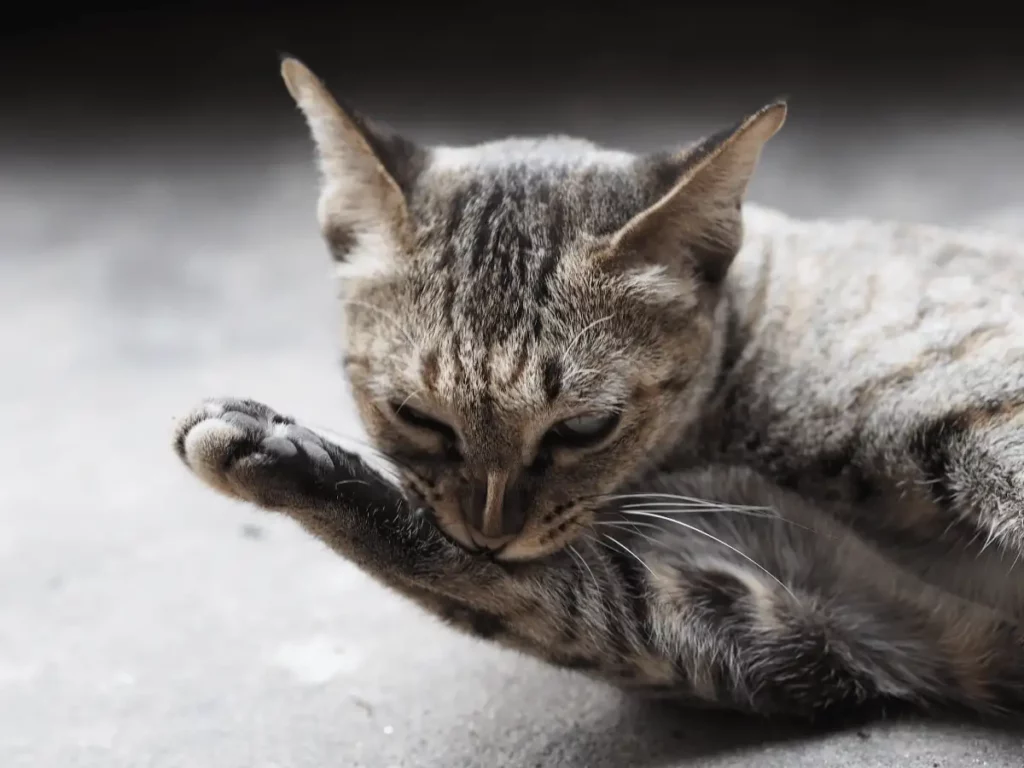
Additionally, you might notice your cat biting their skin more frequently. This is another common reaction to flea bites and can result in hair loss or open sores if not addressed promptly.
Noticing these behavioral changes can be tricky, especially if your cat is generally a groomer. But keep an eye out for signs of distress, like restlessness or agitation. These are clear indications that something’s bothering your furry friend.
Physical Evidence: Spotting Flea Dirt and Anemia Symptoms
Flea dirt, also known as flea feces, looks like tiny black specks or grains of pepper. It’s a surefire sign that fleas are present. Try this simple test to confirm: Place some of the black specks on a moistened paper towel. If they turn a rusty red, it’s flea dirt.
Fleas can cause anemia in cats with severe infestations. Symptoms might include pale gums, lethargy, and loss of appetite. It happens because fleas feed on your cat’s blood, and a heavy infestation could lead to significant blood loss.
Flea Treatment Strategies
Fleas are one of the most common and troublesome pests that can invade our feline friends’ lives. But worry not; here are some of the most effective ways to tackle them.
1. Spot-On Treatments
Spot-on treatments are a widely used option among cat owners for flea prevention due to their convenience and effectiveness.. And it’s easy to see why. These treatments are simple to use and can start killing fleas within a few hours.
Now, you might wonder, “How do I use them?” Spot-on treatments are applied directly to your cat’s skin, usually at the back of the neck or between the shoulder blades. Once applied, they spread over your cat’s body, killing fleas on contact.
2. Household Flea Sprays
What about those pesky fleas that have jumped off your cat and are now happily breeding on your carpet? That’s where household flea sprays come in handy.
These sprays can be used on carpets, furniture, pet bedding, and other areas where fleas may be lurking. They kill adult fleas and disrupt the life cycle of younger fleas, preventing them from growing into adults.
3. Flea Shampoos
Have you ever tried bathing a cat? If you have, you know it can be a bit of an adventure. But sometimes, it’s necessary. Flea shampoos are a great way to give your cat immediate relief from the itching and scratching caused by a flea infestation.
Flea shampoos contain ingredients that kill fleas on contact. You simply wet your cat, apply the shampoo, lather, and rinse. Just be sure to avoid their eyes and ears.
4. Professional Extermination
Despite our best efforts, flea infestations sometimes get out of hand. If you’ve tried everything and still can’t get the situation under control, it might be time to call in the professionals.
Professional exterminators can treat your home with pesticides that are safe for pets and humans and provide advice on how to prevent future infestations.
5. Oral Medications
Oral medications are another effective way to treat flea infestations. These medications are usually available by prescription and are given to your cat by mouth. They work by killing fleas once they bite your cat.
Administering oral medication can be tricky, especially if your cat isn’t a fan of taking pills. One trick to make the process easier is hiding the pill in a treat or using a pill dispenser. If not, now might be the perfect time to take the cat to a vet for a shot.
Pro-Tip
Make sure to treat any secondary problems that might arise as a result of flea infestation, such as skin infections and tapeworms.
Preventing Flea Infestations
1. Flea Inspections
Early flea detection is crucial in preventing a full-blown infestation. Regular flea inspections are your first line of defense and are easier than you may think. Focus on your cat’s armpits, groin, and ears—these are the cozy spots where fleas love to hide. When inspecting, what should you be looking for? Aside from the fleas themselves, keep an eye out for flea dirt, which is essentially flea droppings. Gross, I know, but it’s an unmistakable sign of infestation.
2. Regular Combing
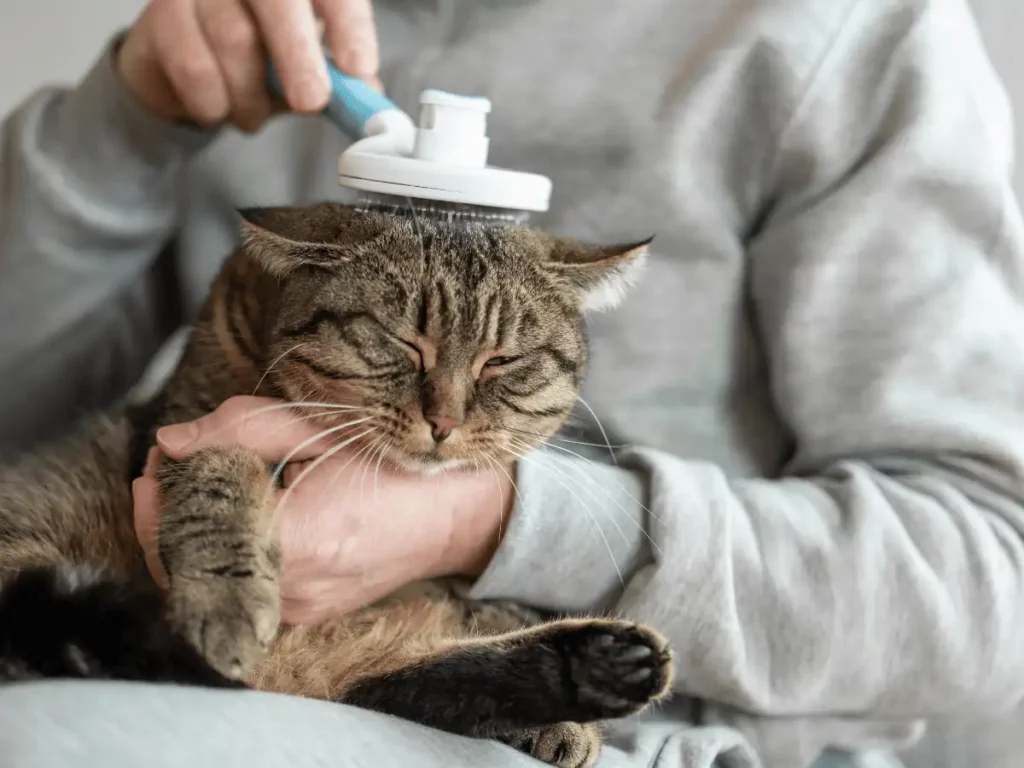
Another simple yet effective measure is regular combing. It helps keep your feline friend’s coat looking fabulous and is an early flea detection system.
A flea comb is a must-have tool for any cat parent. These combs have fine, closely spaced teeth that can hook onto fleas and remove them from your cat’s fur. As a bonus, combing your cat regularly can also strengthen your bond with your feline friend.
3. Keeping Beddings Clean
Did you know fleas can lay eggs in your cat’s bedding and blankets? A simple solution is washing your pet’s bedding and blankets at 60 degrees Celsius (140 degrees Fahrenheit), effectively eliminating flea eggs and larvae.
Pro-Tip
When washing your pet’s bedding or fabrics, using a pet-safe, non-bio detergent can help maintain cleanliness without harming your cat.
4. Frequent Vacuuming
A study by Ohio State University found that vacuuming killed 96% of adult fleas and 100% of younger fleas. Regularly vacuuming your carpet and upholstery, can effectively evict these unwelcome guests before they can settle in.
To maximize the benefits of vacuuming, try doing it at least once a week, paying particular attention to areas where your cat likes to hang out. The best part is that you’ll be ridding your space of furballs and tracked litter.
Pro-Tip
Remember to empty the vacuum bag or canister immediately after cleaning, preferably outside, to prevent any surviving fleas from making a comeback.
5. Yard Maintenance
Mowing the grass disrupts the ideal habitat for fleas. But don’t stop there. Take it further by using pet-friendly insecticides to wipe out any surviving pests. One such insecticide is diatomaceous earth, a natural product that kills fleas without harming your feline friend.
Raking leaves and debris is also an effective method to disrupt flea habitats. Fleas love hiding in piles of leaves, so the sooner you break these up, the less likely your cat will encounter these pests.
6. Flea Preventatives
Flea preventatives come in various forms, such as topical treatments, oral medications, or flea collars. Each has its pros and cons, but all are designed with one purpose in mind: to keep your cat flea-free.
Topical treatments, for instance, are applied directly to your cat’s skin. They kill fleas on contact before they have a chance to lay eggs. Oral medications, on the other hand, work internally to kill fleas at various life stages. Consult your vet about what oral medications are suitable for flea preventatives.
And then we have flea collars. They are infused with chemicals that repel and kill fleas, providing your cat with long-lasting protection.
7. Limiting Outdoor Time
When possible, limit your cat’s outdoor time, especially during peak flea season. If your feline friend is an indoor-outdoor cat, consider creating a safe, enclosed outdoor area. This way, they can still enjoy the outdoors without the risk of mingling with potential flea carriers.
It’s a tough call, especially if your feline friend enjoys outdoor adventures, but remember safety first.
8. Rodent Control
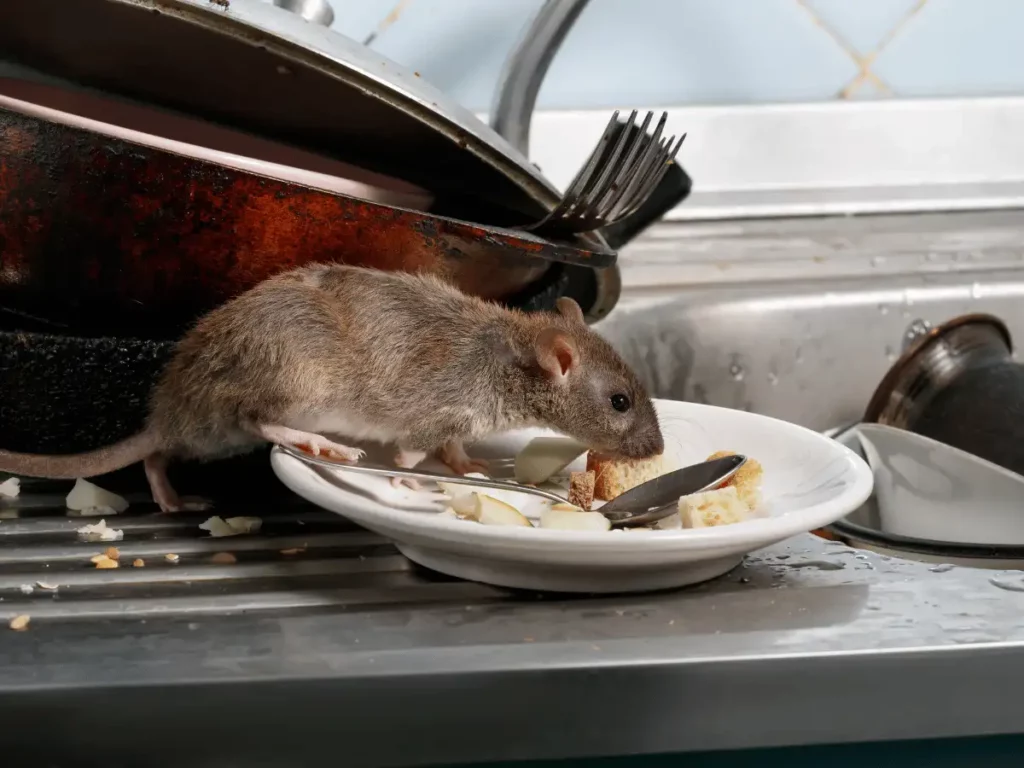
Rodent-proofing your home is a crucial step in flea prevention. Seal up any holes or cracks in walls, doorways, or windows that a rodent could use to gain access. Keep food stored in airtight containers, and take out the trash regularly.
9. Annual Vet Checks
Regular vet visits are essential in detecting early signs of fleas and treating them before they become a significant issue.
During these wellness checks, the vet will likely conduct a physical examination, looking for common signs of fleas such as itchy skin, redness, and irritation. They may also offer professional advice on the best flea treatments and preventive measures for your specific cat.
10. Monitoring House Guests
Visitors, especially those with pets, could unintentionally bring fleas into your home.
One way to tackle this is by politely asking your guests if their pets are on a regular flea prevention regimen. You could also keep a designated area for visitor pets that’s separate from your cat’s usual hangout spots.
Of course, we’re not suggesting you turn away your guests at the door, but a little precaution can go a long way in keeping your home flea-free.
Conclusion
Even though our purr-fect pals enjoy the comfy indoors, it doesn’t mean they’re safe from the irritating issue of fleas. In this article, we’ve discovered that safeguarding our indoor cats is all about recognizing how these uninvited guests sneak in and how we can stop them in their tracks.
Remember, no matter what treatment method you choose, consistency is the key to managing fleas. Keep up with your chosen treatment plan, and your cat will be back to their comfortable, scratch-free self in no time.
Frequently Asked Questions
How likely is it for an indoor cat to get fleas?
Even though indoor cats have a lower risk of getting fleas, it’s not impossible. Fleas can hitch a ride on your clothing or other pets or even come in with rodent invaders.
Can fleas transmit diseases to my indoor cat?
Yes, they can. Fleas can transmit diseases like Bartonella (cat scratch disease) and tapeworms. That’s why it’s crucial to prevent fleas in the first place.
How can I tell if flea treatments are working on my indoor cat?
You’ll notice fewer fleas on your cat and around your home. Plus, your cat will be less itchy, and any flea feces (also known as ‘flea dirt’) will start to disappear from their coat.
What natural remedies can I use to treat fleas on my indoor cat?
While natural remedies like diatomaceous earth, apple cider vinegar, and certain essential oils can help, they’re not as effective as vet-recommended treatments. Always consult with your vet before trying a new treatment.
